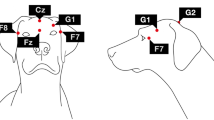Abstract
Single-hemisphere low-wave sleep was shown to be the dominant form of natural sleep according to quantitative analysis of duration of ECoG sleep phases. Combined variants of bilateral and unilateral ECoG synchronization total 33.4% of the 24-h cycle, of which unilateral slow-wave sleep accounts for 28.8%. Each of the bottlenose dolphin's two hemispheres remains in a state of slow-wave ECoG for an average of 19% of the cycle. The highest percentage duration of sleep occurred during the afternoon and nighttime. Overall duration of ECoG synchronization may differ in the two hemispheres but evens out in the dolphin over a number of 24-h cycles. Spells of single-hemisphere sleep tend to alternate between the two different hemispheres.
Similar content being viewed by others
Literature Cited
L. M. Mukhametov, “Comparative physiology of sleep in mammals,” in: Achievements of Science and Technology (Human and Animal Physiology series),31, 111–177 (1986).
L. M. Mukhametov, O. I. Lyamin, and I. G. Polyakova, “Sleep and waking in North Sea Seals,” Zh. Vyssh. Nerv. Deyat.,34, No. 3, 465–471 (1984).
L. M. Mukhametov and I. G. Polyakova, “Electroencephalographic research into sleep in the common porpoise,” Zh. Vyssh. Nerv. Deyat.,31, No. 2, 333–339 (1981).
L. M. Mukhametov and A. Ya. Supin, “Sleep and waking in dolphins” in: Marine Mammals: Research Techniques and Results, Nauka, Moscow (1978), pp. 66–77
L. M. Mukhametov, A. Ya. Supin, and I. G. Strokova, “Interhemisphere asymmetry of functional brain state during sleep in dolphins,” Dokl. Akad. Nauk. SSSR,229, No. 3, 767–770 (1976).
J. M. Affanni and E. Morita, “Asimetria bioeléctica de las cortezas de ambos hemisferios cerebrales en el marsupial (Didelphis azarae). Effectos de la seccion de las comisuras telencefálie cas,” Rev. Soc. Argent. Biol.,42, No. 5/8, 99–105 (1966)
T. Allison, H. Van Twyver, and W. R. Goff, “Electrophysiological studies of the echidna,Tachyglossus aculeatus. 1. Waking and sleep,” Arch. Ital. Biol.,110, No. 2, 145–184 (1972).
N. J. Ball, C. J. Amlaner, J. P. Shaffery, and M. R. Opp, “Asynchronous eye closure and hemispheric quiet sleep of birds,” Abstr. 8th Eur. Congr. Sleep Research, Szeged, 19 (1986).
G. Berlucchi, “Electroencephalographic studies in “split brain” cats,” Electroencephalogr. Clin. Neurophysiol.,20, No. 3, 348–356 (1966).
F. Michel, “Sleep and waking in cats with various sagittal sections of the brain,” In: Cerebral Interhemispheric Relations, J. Gernáček and F. Podivinský, editors, Bratislava (1972), pp. 83–97.
L. M. Mukhametov, “Sleep in marine mammals,” Exp. Brain Res., Suppl. 8, 227–238 (1984).
L. M. Mukhametov, A. Y. Supin, and I. G. Polyakova, “Interhemispheric asymmetry of the electroencephalographic sleep patterns in dolphins,” Brain Res.,134, No. 3, 581–584 (1977).
K. S. Norris and T. P. Dohl, “The structure and functions of cetacean schools,” In: Cetacean Behavior: Mechanisms and Functions, L. M. Herman, editor, John Wiley & Sons, New York (1980), pp. 211–261.
Additional information
A. N. Severtsov Institute of Evolutionary Morphology and Animal Ecology. Translated from Neirofiziologiya, Vol. 20, No. 4, pp. 532–538, July–August, 1988.
Rights and permissions
About this article
Cite this article
Mukhametov, L.M., Oleksenko, A.I. & Polyakova, I.G. Quantification of ECoG stages of sleep in the bottlenose dolphin. Neurophysiology 20, 398–403 (1988). https://doi.org/10.1007/BF02198450
Received:
Issue Date:
DOI: https://doi.org/10.1007/BF02198450




